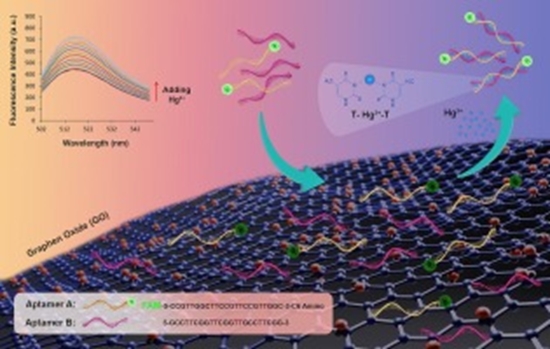Mercury (II) sensing using a simple turn-on fluorescent graphene oxide based aptasensor in serum and water samples
Abstract A simple, highly sensitive, and selective fluorometric aptasensing platform based on aptamer and graphene oxide (GO) is proposed for the determination of mercury (II) ion (Hg2+). In the designed assay, two aptamer probes, a carboxy-fluorescein (FAM) labeled aptamer (aptamer A) and its complementary (aptamer B) with partial complement containing several mismatches and GO as the quencher were used.

Abstract
A simple, highly sensitive, and selective fluorometric aptasensing platform based on aptamer and graphene oxide (GO) is proposed for the determination of mercury (II) ion (Hg2+). In the designed assay, two aptamer probes, a carboxy-fluorescein (FAM) labeled aptamer (aptamer A) and its complementary (aptamer B) with partial complement containing several mismatches and GO as the quencher were used. In the absence of Hg2+, both A and B aptamers were adsorbed on the surface of GO by π-π-stacking, leading to fluorescence quenching of FAM due to fluorescence resonance energy transfer (FRET). Upon exposure to Hg2+, the A and B aptamer strands bind Hg2+ and form T-Hg2+-T complexes, leading to the formation of a stable double-stranded aptamer. The double-stranded aptamer is detached from the GO surface, resulting in the recovery of FAM fluorescence. The fluorescence intensity (FI) of the developed sensor was correlated with the Hg2+ concentration under optimized experimental conditions in two wide linear ranges, even in the presence of 10 divalent cations as interferences. The linear ranges were obtained from 200.0 to 900.0 fM and 5.0 to 33.0 pM, a limit of detection (LOD) of 106.0 fM, and a limit of quantification (LOQ) of 321.3 fM. The concentration of Hg2+ was determined in five real samples containing three water and two serum samples, using spiking and standard addition methods and the results were compared with the spiked amounts and atomic absorption (AAS) as standard method respectively, with acceptable recoveries. Furthermore, in the standard addition method, to overcome the effects of matrix influence of real samples in quantitative predictions, the excitation-emission matrix (EEM) data for samples was simultaneously analyzed by multivariate curve resolution with alternating least squares (MCR-ALS) as a second-order standard addition method (SOSAM).




ارسال به دوستان